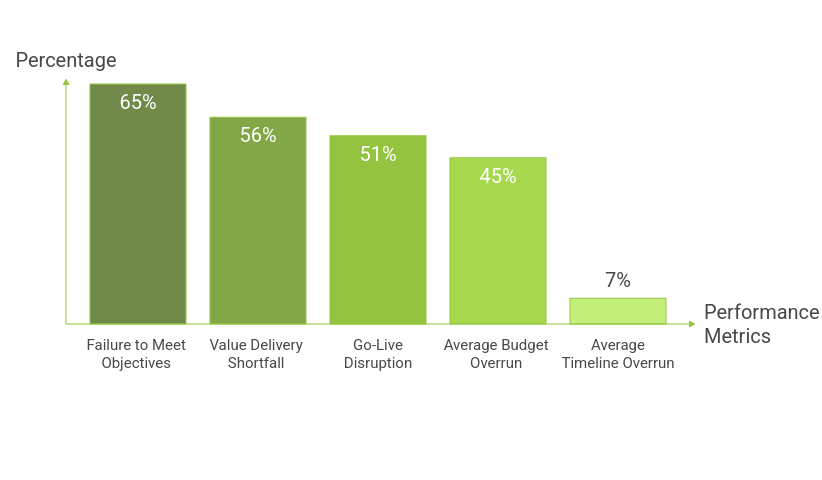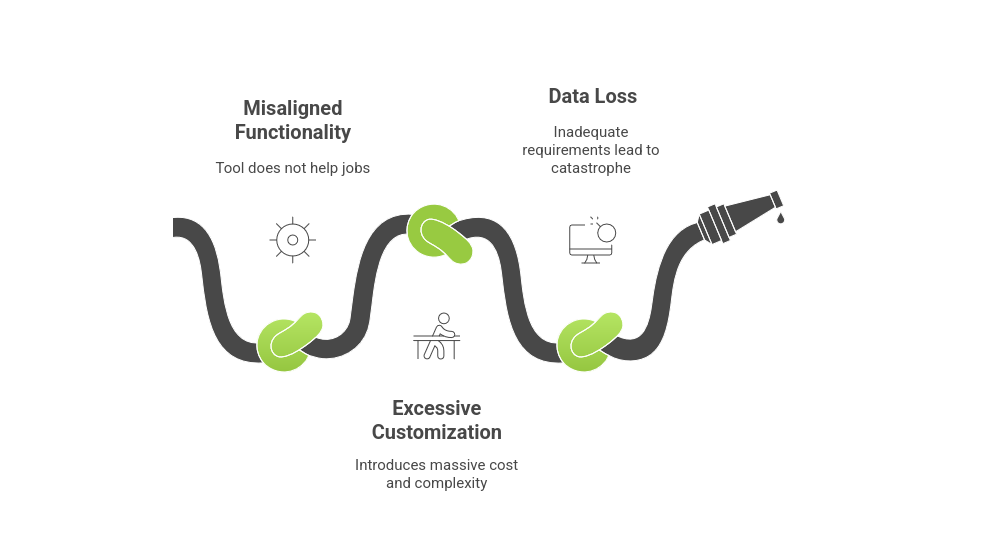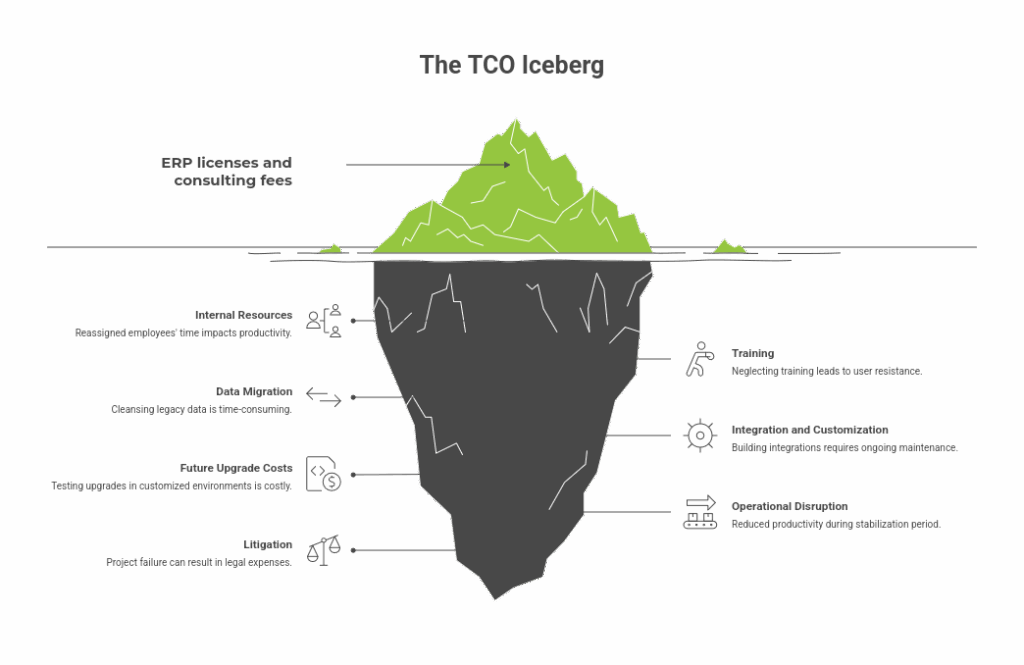A Strategic Analysis of ERP Implementation Failure: A Definitive Guide on What to Avoid
What are the defining factors of ERP Implementation Failure?
ERP implementation is a profound, high-stake business transformation that fundamentally alters an organization’s core processes, data structures, and human workflows. While the advertised benefits include streamlined operations and better decision-making, the path to achieving these outcomes is filled with risks.
The data on ERP implementation project outcomes is exceptionally little. Research from Gartner finds that a staggering 55% to 75% of all ERP projects fail to meet their objectives. “Failure” in this context is not merely a project’s complete abandonment; it is a failure to meet the original business goals, a reality for 70% of recently implemented initiatives.
The financial consequences of these failures are severe, though the data reveals two distinct levels of risk. A landmark 2012 study by McKinsey, in collaboration with the University of Oxford, on over 5,400 large-scale IT projects (defined as those with initial price tags over $15 million) found that, on average, these projects run 45% over budget and 7% over time. While alarming, this 45% average masks a more volatile and catastrophic risk profile. Other industry analyses by Netsuite report that most ERP projects exceed their initial budgets by three to four times (300-400%) and experience timeline extensions of 30%.
These figures are not contradictory. They illustrate that while the average project is significantly over budget, a substantial number of projects spin into “black swan” events (McKinsey, 2012) that result in 300-400% overruns. In fact, the McKinsey data shows 17% of IT projects go so badly they can “threaten the very existence of the company”.
However, the most critical statistic of all is not about budgets or timelines; it is about value. The same McKinsey & Oxford study found that these large IT projects deliver, on average, 56% less value than predicted. This single data point provides the central thesis for understanding ERP failure. The 56% value deficit, paired with a relatively “modest” 7% average time overrun, proves that projects are not primarily failing due to poor project management. They are failing because of flawed strategy. Organizations have become alarmingly efficient at implementing systems that fail to deliver the promised business value.
This failure is not a distant, abstract concept. It has an immediate, tangible impact: 51% of companies report experiencing significant operational disruptions when their new ERP systems go live (NetSuite, n.d.), impacting everything from payroll to order fulfillment. Before embarking on an ERP transformation, it is imperative for leadership to understand that the project is not a technical challenge but a strategic one. The primary risks are not embedded in the software code but in the organization’s planning, culture, and governance.

Looking for a Future-Proof IT Strategy?
Get in touch with us!
The foundation of every successful IT project is a well-thought-out strategy. We begin with a no-obligation initial consultation to understand your business, your goals, and how technology can move you forward.
Avoiding Strategic and Planning Failures
ERP implementation projects are not lost in the execution phase; they are lost at the moment of conception. The data overwhelmingly shows that failures are rarely caused by software alone. Instead, they collapse under the weight of organizational misalignment, flawed planning, and overconfidence in timelines. The most major mistakes are made before the implementation partner is ever selected.
1. The "Phase Zero" Imperative: Failure to Define Strategy
The most overlooked step in a digital transformation is “Phase Zero” which is the foundational or pre-implementation strategic work. In a fast-paced market, organizations often rush directly into vendor selection to show quick progress. However, without a clear blueprint, defined business case, or aligned strategy, this speed can become a problem.
This is a fundamental misunderstanding of the challenge. An ERP implementation is not an IT project; it is a “business transformation”. The real problem is not speed, it’s clarity. While project delays are frequently attributed to technical hurdles but the true bottleneck is often internal alignment. If the strategy is not established early, decisions must be “made in real time, under pressure, with consultants on the clock”
Investing in this to have clarity from day one is the most effective way to prevent ERP implementation failures. By prioritizing strategy and structure before software selection, organizations can avoid a reactive, chaotic implementation. The goal is to move from fixing planning mid-project to establishing a robust roadmap that guides every subsequent decision.
2. Poor Requirements Definition
A direct and damaging consequence of a failed “Phase Zero” results in inadequate requirements gathering. When an organization rushes into a project, it fails to invest the intellectual effort required to deeply investigate, develop, and define its true needs.
This is the technical manifestation of the “Garbage In, Garbage Out” principle. A poor requirements definition, often treated as a simple checklist, can lead to failure of ERP implementation projects and creates a cascade of devastating, downstream consequences.
Misaligned Functionality: The resulting system fails to align with critical business processes or objectives (NetSuite, n.d.-a), leaving employees with a tool that does not help them do their jobs.
Risk of Excessive Customization: This is the most damaging outcome. When the team discovers, mid-implementation, that the standard software does not meet an un-gathered requirement, they are forced to compensate. This leads to over-customization which introduces massive cost, complexity, and long-term technical debt.
Risk of Data Loss or Corruption: Inadequate requirements for data and integration lead to catastrophe. For example, if a new HR module’s requirements differ in key fields from the legacy database, the data migration may suffer “partial or total data loss”.

3. Automating Inefficiency: The Business Process Re-engineering (BPR) Failure
Perhaps the strategic alternative to customization is Business Process Re-engineering (BPR) (Mhaskey et al., n.d.). The guiding principle for any ERP implementation must be: “If processes aren’t optimized before they’re automated, then you’ll automate inefficiencies”.
Modern ERP systems are already designed with best practices and optimized workflows built in (Acumatica, n.d.). The goal of an implementation should be to seize the opportunity to re-engineer the company’s legacy processes to align with these efficient, standard workflows, thereby eliminating bottlenecks, reducing costs, and improving quality (ISCAP, 2014).
Interestingly, insufficient testing and not enough process reengineering are the two most frequently reported implementation challenges (NetSuite, n.d.-b). This reveals a fundamental conflict at the heart of implementation. The BPR vs. customization debate is a ”pay now or pay forever” choice. BPR (pay now) is politically difficult and painful. It requires powerful department heads to change workflows they have used for decades. Customization (pay forever) is politically easy. It allows every department to keep its broken, unique process while the IT guys just make the software work.
This decision is the real test of an product owner. A weak product owner will yield to political pressure and allow customization, dooming the project to long-term technical failure. While a strong product owner will absorb the political heat of enforcing BPR to unlock the true value of the transformation.
4. The Scope & Data Failures
Scope Creep: This is the uncontrolled addition of new features and capabilities that were not in the original plan (NetSuite, n.d.-a). It is a primary driver of delays and budget overruns. It is often caused by a simple lack of communication or the project lead’s inability to say no (Forbes, n.d.).
Data Migration: Teams fail to cleanse legacy data, resulting in data loss and inaccuracies and data accuracy being a top post-launch complaint.
5. Going Live Early
Insufficient testing is the other most commonly cited ERP implementation challenge (NetSuite, n.d.-b). Under pressure from unreasonable deadlines (SciSpace, n.d.), teams rush projects to go-live without proper testing.
The Revlon failure is the ultimate tale. The company’s 2018 SAP S/4HANA implementation suffered from a lack of design and maintenance of effective controls (Spinnaker Support, 2023). This untested, non-functional system was deployed, with immediate and catastrophic results: it prevented their North Carolina manufacturing facility from fulfilling $64 million in orders. The ensuing operational and supply chain chaos directly contributed to a $70.3 million net loss that year and triggered a wave of shareholder lawsuits.
6. Selecting the Wrong Partner for ERP Implementation
Choosing the wrong ERP system or the wrong implementation partner are one of the primary sources of failure. More commonly, the failure lies with the systems integrator (SI), the consulting firm hired to manage the implementation. A lack of experience in the client’s specific industry is a major red flag.
National Grid: The utility giant’s infamous SAP failure was blamed on its systems integrator, Wipro. National Grid claimed Wipro “did not have experience implementing SAP in the U.S. utility industry”. The result was significant operational disruption and a staggering $585 million in remediation costs, which required hiring 850 contractors at a cost of over $30 million per month to fix the system (Spinnaker Support, 2023).
MillerCoors: This case is another example of partner and contract failure. In 2014, the brewing company hired HCL Technologies to unify its seven disparate SAP instances. The project failed so badly that in 2017, MillerCoors sued HCL for $100 million. MillerCoors’ claim was that HCL hadn’t allocated the proper resources. HCL countersued, blaming internal mismanagement at MillerCoors. The ultimate lesson from the lawsuit: the ERP contracts were poorly defined and loosely based, setting the stage for a dispute where neither party had a clear definition of success or responsibility.
Exciting industry news and updates on open source, Odoo and initOS solutions in our newsletter.
Subscribe now!
To be able to load the contact form, you must allow external services
7. The TCO Iceberg: Failing to Budget for Hidden Costs
Budgets collapse not because of minor miscalculations, but because the entire financial model is wrong from the start. Most ERP implementation budgets collapse early because organizations make the mistake of budgeting only for ERP licenses and consulting fees.
The failure to budget for the Total Cost of Ownership (TCO) is a primary driver of perceived overruns. The hidden costs that are consistently missed (NetSuite, n.d.-c) create a financial “iceberg” that sinks the project. These predictable-but-unbudgeted costs include:
-
Internal Resources: The people cost of reassigning an organization’s best employees from their full-time jobs to the project team (NetSuite, n.d.-c).
-
Training and OCM: These are often the first items cut from a tight budget, which, as seen in the Mission Produce case, is a fatal error (NetSuite, n.d.-c).
-
Data Migration: The cost of cleansing and migrating decades of legacy data (NetSuite, n.d.-c).
-
Integration and Customization: Fees for building and maintaining integrations to other critical systems (NetSuite, n.d.-c).
-
Future Upgrade Costs: The cost of implementing and testing the vendor-supplied upgrades, especially in a customized environment (NetSuite, n.d.-c).
-
Operational Disruption: The cost of short-term reduced productivity during the go-live stabilization period (NetSuite, n.d.-c).
-
Litigation: The ultimate hidden cost when the project fails.

These two failures, partner selection and TCO, are not independent. They are causally linked. An executive who fails to model the full TCO establishes an unrealistically low budget. This flawed budget forces the selection team to be price sensitive, making the common mistake of choosing based primarily on cost. This, in turn, leads them to select a cheap partner, who is cheap precisely because they also omit these hidden costs from their bid and, like Wipro at National Grid, lack the deep, expensive industry experience required for success.
In many cases, the project’s subsequent cost overrun is not an overrun; it is simply the real cost of the project finally appearing. The failure to budget for TCO from Day 1 guarantees the selection of a low-quality partner, which in turn guarantees the project’s failure.
The SME Paradox: Navigating Risks in the European Owner-Led Context
While the large-scale failures of Revlon and National Grid provide dramatic cautionary tales, they often feel distant to the reality of Small and Medium-sized Enterprises (SMEs), particularly within the European market. Data from Eurostat reveals a significant digital divide: while 86% of large EU enterprises have implemented ERP software, only 38% of small enterprises have done the same (Eurostat, 2024). The Trovarit study “ERP in Practice 2024,” which focuses specifically on the German-speaking (DACH) region, confirms that while system satisfaction is generally stable, the success of these projects hinges on factors distinct from the US enterprise market (Trovarit, n.d.).
For owner-led SMEs (the Mittelstand), the risk profile is unique and requires a tailored approach:
The Owner-Centric Risk: In owner-led companies, the owner is often the primary decision-maker and a potential single point of failure. Unlike large corporations with steering committees, an SME owner’s personal stance, whether they are a champion of change or a bottleneck holding onto legacy processes can single-handedly dictate the project’s success (Hustad & Olsen, 2019). A lack of clear strategic vision from the owner often leads to the “digitization of chaos,” where old, inefficient habits are simply hard-coded into the new system.
The Skills Gap: European SMEs face a persistent digital skills shortage. Eurostat data shows that while 73% of large EU enterprises provide ICT training to their staff, only 21% of SMEs do the same (Eurostat, 2025). This means SMEs often lack the internal “Super Users” or dedicated IT project managers required to challenge vendors and drive adoption. Without a strong internal IT team, the company becomes dangerously dependent on external partners
Conclusion: Reframing Success to Strategic Value
The analysis of ERP implementation pitfalls reveals an unequivocal and consistent theme: projects do not fail for technical reasons. The software, in almost all cases, works. The failures are overwhelmingly human, strategic, and political.
The avoidance of these pitfalls can be summarized into a series of causal chains that executive leaders must manage:
The Conceptual Chain: A project’s success is determined in Phase Zero. A failure to define the strategic “why” and business blueprint before selection leads directly to poor requirements, which in turn guarantees a fictional budget and timeline (SciSpace, n.d.).
The Human Chain: An Product Owner’s false perception that people are ready for change is the root of human failure. It leads to the de-funding of OCM, which manifests as inadequate training and user resistance, crippling adoption.
The Process Chain: The “pay now or pay forever” decision between BPR and customization is the implementation’s most critical test. Enforcing BPR is politically difficult but strategically vital. Allowing customization is politically easy but creates a permanent, costly technical debt that destroys agility.
The Financial Chain: A failure to model the complete Total Cost of Ownership (TCO) is not a simple accounting error; it is a strategic error that causes the selection of low-cost and low-quality partners resulting in failures.
Ultimately, organizations must avoid the perception of an ERP as a technology product to be installed. It must be treated as a complete business transformation. The risk is not in the software; it is in the organization’s unwillingness to commit to the deep, difficult, and foundational work on its own strategy, processes, and culture.
Our Approach: Strategic Partnerships
For SMEs facing these specific hurdles, the choice of implementation partner becomes the decisive success factor. We specialize in bridging this exact gap for owner-led companies with smaller budgets. Unlike vendors who merely sell software licenses and leave, we operate as a strategic consultant and long-term partner. Our methodology is designed to de-risk the SME implementation by:
Consulting before Coding: We focus on developing a future-proof IT concept and strategy before technical implementation begins, ensuring the owner’s vision is translated into a workable roadmap.
Collaborative Integration: Recognizing the internal skills gap, we integrate and work collaboratively with the client’s existing staff and domain experts, actively transferring knowledge rather than creating dependency.
Managing Project Risk: Instead of selling a “happy path” story, we actively manage the specific risks of the SME environment, guiding the project strategically to ensuring the investment drives actual business growth.
To be able to load the contact form, you must allow external services
Latest Posts

ERP Implementation: The Ultimate 7 Factors to Avoid
A Strategic Analysis of ERP Implementation Failure: A Definitive Guide on What to Avoid What are the defining factors of ERP Implementation Failure? ERP implementation is a profound, high-stake business transformation that fundamentally alters an organization’s core processes, data structures, and human workflows. While the advertised benefits include streamlined operations and better decision-making, the path

How to Odoo: Timesheets
Time recording in Odoo using timesheets: How employer meet the legal requirements In a decision of 13. On September 2022, the Federal Labour Court (BAG) has stipulated that employing parties must record the entire working time of their employees. In this article you will learn how to honour this commitment by using Odoo. What are
References
Acumatica. (n.d.). What Comes First: Business Process Reengineering or ERP Implementation? Acumatica. https://www.acumatica.com/blog/what-comes-first-business-process-reengineering-or-erp-implementation/
Eurostat. (2024). E-business integration. https://ec.europa.eu/eurostat/statistics-explained/index.php/E-business_integration
Eurostat. (2025). Digitalisation in Europe – 2024 edition. https://ec.europa.eu/eurostat/web/interactive-publications/digitalisation-2025
Forbes. (n.d.). What Is Scope Creep In Project Management? Forbes Advisor. https://www.forbes.com/advisor/business/scope-creep/
Gartner. (n.d.). Enterprise Resource Planning (ERP). Gartner. https://www.gartner.com/en/information-technology/topics/enterprise-resource-planning
Hustad, E., & Olsen, D. H. (2019). ERP Implementation in an SME: a Failure Case. ResearchGate. https://www.researchgate.net/publication/300162456_ERP_Implementation_in_an_SME_A_Failure_Case
ISCAP. (2014). ERP Implementation, Business Process Reengineering and Firm Performance. Proceedings of the 2014 CONISAR. https://iscap.us/proceedings/conisar/2014/pdf/3316.pdf
McKinsey. (2012, June). Delivering large-scale IT projects on time, on budget, and on value. https://www.mckinsey.com/capabilities/tech-and-ai/our-insights/delivering-large-scale-it-projects-on-time-on-budget-and-on-value
MDPI. (2021, November). Implementation of ERP Systems in SMEs: A Systematic Literature Review. Applied Sciences. https://www.mdpi.com/2078-2489/12/11/478
Mhaskey, D., et al. (n.d.). A Study on ERP (Enterprise Resource Planning) Customization. International Journal of Computer Applications (IJCA). https://www.ijcaonline.org/archives/volume187/number22/mhaskey-2025-ijca-925366.pdf
NetSuite. (n.d.-a). ERP Failure: Why Implementations Fail and How to Avoid It. https://www.netsuite.com/portal/resource/articles/erp/erp-failure.shtml
NetSuite. (n.d.-b). ERP Statistics. https://www.netsuite.com/portal/resource/articles/erp/erp-statistics.shtml
NetSuite. (n.d.-c). Total Cost of Ownership (TCO) for ERP. https://www.netsuite.com/portal/resource/articles/erp/erp-tco.shtml
Oracle. (n.d.-a). Customization vs. Configuration. Oracle Blogs. https://blogs.oracle.com/erp-ace/customization-vs-configuration
Oracle. (n.d.-b). How to Calculate the ROI of an ERP System. https://www.oracle.com/apac/erp/roi-erp/
Prosci. (n.d.). 3 Reasons Executives Fail at Sponsorship. Prosci. https://www.prosci.com/blog/3-reasons-executives-fail-at-sponsorship
Project Management Institute (PMI). (n.d.). Executive Sponsor Engagement. https://www.pmi.org/-/media/pmi/documents/public/pdf/learning/thought-leadership/pulse/executive-sponsor-engagement.pdf
ResearchGate. (n.d.). Critical Failure Factors in ERP Implementation: A Systematic Literature Review. https://www.researchgate.net/publication/370394801_Critical_Failure_Factors_in_ERP_Implementation_A_Systematic_Literature_Review
SAP. (n.d.-a). ERP Implementation Best Practices. SAP. https://www.sap.com/products/erp/what-is-erp/erp-implementation-best-practices.html
SAP. (n.d.-b). What is ERP? SAP. https://www.sap.com/products/erp/what-is-erp.html
Scholars Bank. (n.d.). The Role of End-User Training in ERP Implementation. University of Oregon. https://scholarsbank.uoregon.edu/bitstreams/87f00a75-eeba-4b52-abf7-c5b4deb3bba3/download
SciSpace. (n.d.). Majority of Enterprise Resource Planning (ERP) Projects Fail. https://scispace.com/pdf/majority-of-enterprise-resource-planning-erp-projects-fail-m-aatzqsrt0k.pdf
Spinnaker Support. (2023, December 13). ERP Implementation Failure: Case Studies and Lessons Learned. https://www.spinnakersupport.com/blog/2023/12/13/erp-implementation-failure/
Trovarit. (n.d.). Studie: ERP in der Praxis 2024/2025. https://www.trovarit.com/studien/erp-in-der-praxis/
WSJ Westscience-Press. (n.d.). Factors influencing the post-implementation user satisfaction of SAP-ERPS. https://wsj.westscience-press.com/index.php/wsist/article/view/1209
